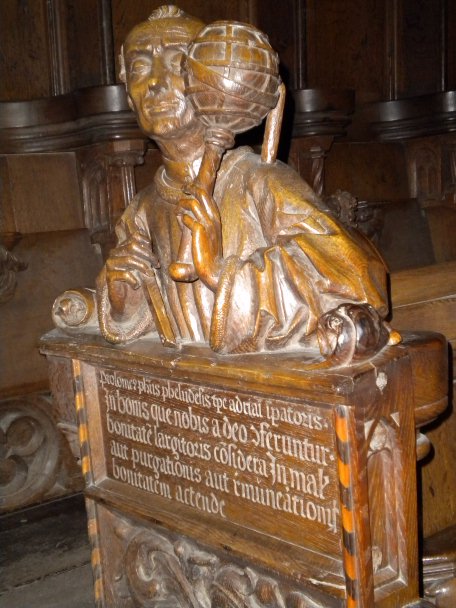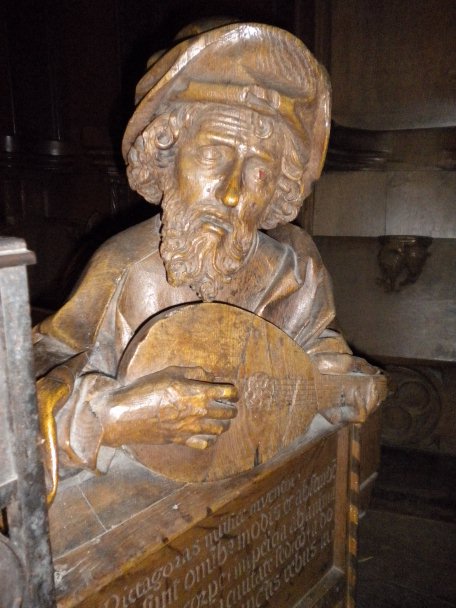



![]() Das Chorgestühl, dem im Wikipedia-Artikel über das
Ulmer Münster ein ganzer
Abschnitt gewidmet ist (siehe auch [2]), besitzt an den Pultwangen
an der Nordseite unter anderem zwei Büsten, die
Claudius
Ptolemäus und
Pythagoras
(siehe auch [3, S. 27])
darstellen. Die darunter eingeschnitzten Texte benennen die dargestellten
Persönlichkeiten. C. Ptolemäus wird mit einer Armillarsphäre, Pythagoras mit
einer Laute dargestellt. Im Text zu Pythagoras wird dieser als Erfinder der Musik
bezeichnet. Letzteres mag überraschen, doch sagt man, dass das noch heute in der
westlichen Welt verwendete System der Tonhöhen auf Pythagoras zurückgeht (vergleiche
[1, S. 116] und auch die Ausführungen zum
Schönen Brunnen in Nürnberg).
Das Chorgestühl, dem im Wikipedia-Artikel über das
Ulmer Münster ein ganzer
Abschnitt gewidmet ist (siehe auch [2]), besitzt an den Pultwangen
an der Nordseite unter anderem zwei Büsten, die
Claudius
Ptolemäus und
Pythagoras
(siehe auch [3, S. 27])
darstellen. Die darunter eingeschnitzten Texte benennen die dargestellten
Persönlichkeiten. C. Ptolemäus wird mit einer Armillarsphäre, Pythagoras mit
einer Laute dargestellt. Im Text zu Pythagoras wird dieser als Erfinder der Musik
bezeichnet. Letzteres mag überraschen, doch sagt man, dass das noch heute in der
westlichen Welt verwendete System der Tonhöhen auf Pythagoras zurückgeht (vergleiche
[1, S. 116] und auch die Ausführungen zum
Schönen Brunnen in Nürnberg).
Die Fotos wurden im Mai 2012 aufgenommen.
![]() The choir-stalls of the minster of Ulm is equipped with some busts of ancient personages.
Two of them are devoted to
Claudius
Ptolemy and
Pythagoras
(see also [3, p. 27]). The texts below the figures mention the
name of the personage. C. Ptolemy is presented with an armillary sphere while Pythagoras
plays a lute. The text explains that Pythagoras was the inventor of music. This may
surprise, but one says that the staff (the musical notes) used in the western world trace
back on Pythagoras (confer [1, p. 116] and also the
explanations on the well called Schöner Brunnen in
Nuremberg).
The choir-stalls of the minster of Ulm is equipped with some busts of ancient personages.
Two of them are devoted to
Claudius
Ptolemy and
Pythagoras
(see also [3, p. 27]). The texts below the figures mention the
name of the personage. C. Ptolemy is presented with an armillary sphere while Pythagoras
plays a lute. The text explains that Pythagoras was the inventor of music. This may
surprise, but one says that the staff (the musical notes) used in the western world trace
back on Pythagoras (confer [1, p. 116] and also the
explanations on the well called Schöner Brunnen in
Nuremberg).
The photographs were taken in May 2012.
| [1] | Hein, Wolfgang: Die Mathematik im Altertum, Wissenschaftliche Buchgesellschaft, Darmstadt, 2012 | |
| [2] | Hoffmann, Moritz: Das Chorgestühl im Ulmer Münster. 2010 | |
| [3] | Wortmann, Reinhard: Das Ulmer Münster. DKV Kunstführer Nr. 286, 8. akt. Aufl. 2010, Deutscher Kunstverlag, Berlin, München |
| Back to the main page | Created by Wolfgang Volk in August 2012 |